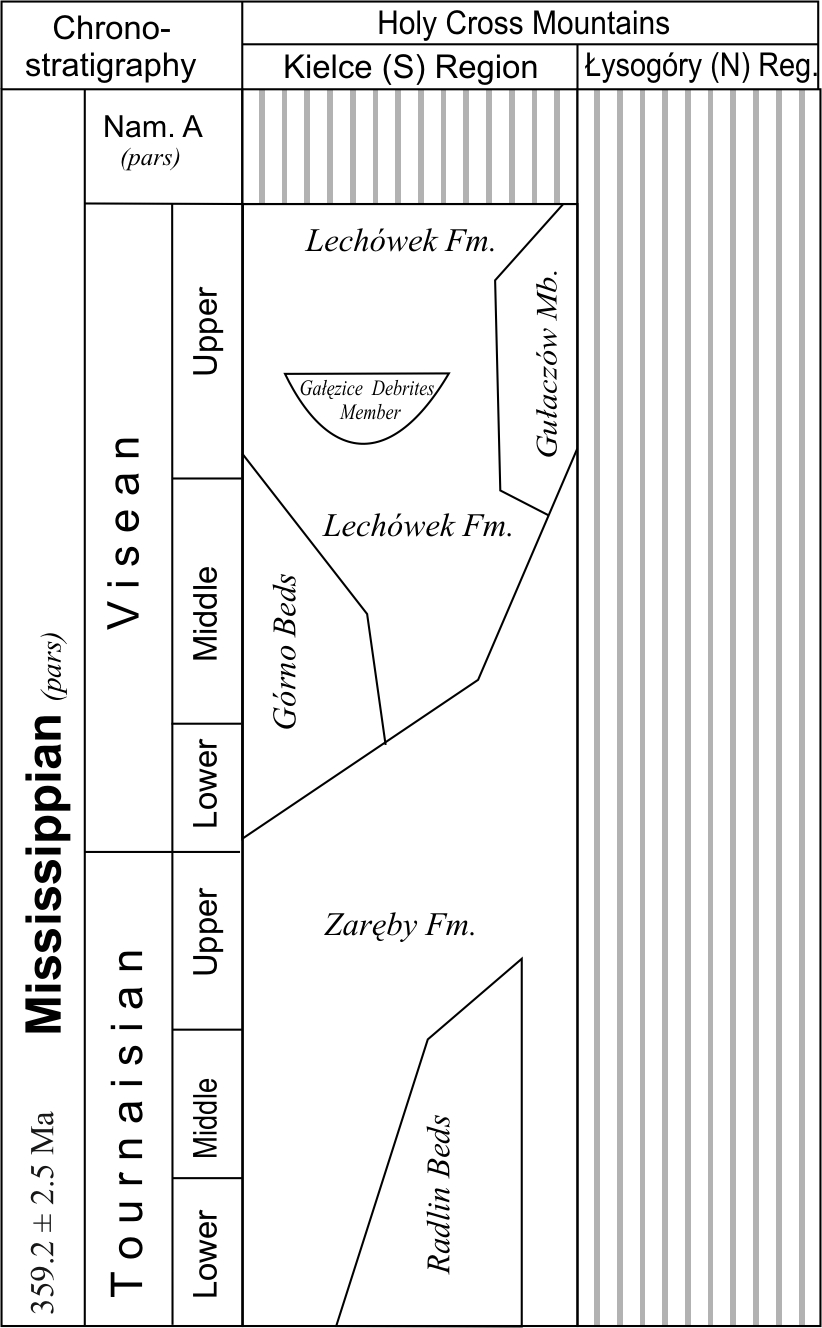Author of the elaboration: prof. dr hab. Stanisław Skompski
The diversified palaeogeography of the Devonian platform became much simpler in the Carboniferous. Progressive break-up and subsidence of particular basement blocks to the south resulted in the early Carboniferous in the Kielce Region (Carboniferous rocks are preserved only here) being covered by a succession of clay-siliceous shales of the Zaręby Formation (Fig. 6; Żakowa and Migaszewski 1995; Malec 2014),

Fig. 6. Simplified lithostratigraphic scheme of the Carboniferous in the Holy Cross Mountains (after Tabela Stratygraficzna Polski [Stratigraphic Chart of Poland] 2008)
representing the Culm facies widely distributed in Europe. Sedimentation of these deep-marine deposits, most probably recording the largest bathymetry in the entire Palaeozoic of the Holy Cross Mountains, was preceded by the deposition of the much shallower Radlin Beds with carbonates that can be observed in two close, but differing in facies, parts of the Gałęzice-Bolechowice Syncline: in Ostrówka Quarry near Gałęzice and Kowala Quarry in the eastern part of the syncline. In the Ostrówka area, condensed Famennian limestones are covered by yellowish-grey clay shales with over 10 cm thick interbeds of limestones and marls. Usually the rocks are devoid of fossils, but occasionally they contain horizons with abundant fossils of trilobites and crinoid stalks, sometimes with distinct graded bedding or lamination. Often the topmost boundaries of these carbonate interbeds are rich in bioturbation structures. The Devonian/Carboniferous boundary in the escarpment of Kowala Quarry (with progressively better exposure resulting from quarrying) is developed in a mixed clay-carbonate facies, but the black colour of the sediments indicates a deeper, anoxic setting, which favoured the perfect preservation of nektonic goniatites. In conclusion, it seems that the beginning of the Carboniferous was characterized by a sub-division of the sea floor into deeper basinal parts and shallower uplifted blocks that was inherited after the Devonian. Elevated parts were the source areas of carbonate material which was periodically transported to the deeper parts of the basin, resulting in the carbonate-marly Radlin Beds. As late as in the late Tournaisian (the oldest age of the Carboniferous), the combined effects of increased subsidence and eustatic sea level rise led to the unification of sedimentation in a relatively deep environment (Szulczewski et al. 1996).
Culm deposits, characterized in detail in the description of Ostrówka Quarry, were formed during more than ten million years and due to their deep-marine character probably also covered the Łysogóry Region, at present devoid of Carboniferous rocks. Their sedimentation was accompanied by volcanism, as recorded by pyroclastic horizons throughout the Carboniferous succession, particularly in its lower part (Żakowa et al. 1984; Chlebowski 1995; Migaszewski 1995). Volcanic activity could have influenced the general abundance of silica in the sea water and the abundant evolution of radiolarians, microorganisms with silica skeletons that are commonly found in the Culm deposits. Such sedimentation continued almost to the end of the Visean (Fig. 6). Low sedimentation rates radically increased in the late Visean and caused a distinct shallowing of the clay facies (Lechówek Formation). Slightly earlier, specific limestone horizons were formed in the vicinity of the village of Gałęzice; these horizons have always been of special interest due to their abundant fossils, significantly distinguishing them from surrounding rocks. The broad literature on this small but unique complex of bioclastic limestones, overflowing with brachiopods, crinoids stalks and corals, is dominated by palaeontological issues, indicating the shallow-marine origin of the rich assemblage of benthic organisms (literature compilations in Żakowa 1981; Bełka and Skompski 1988). The mass occurrence of such fauna has promoted the suggestion that the limestones represent deposits “…of a warm, stable flooding, formed on a shelf shallow, with normal salinity and perfect oxygenation…” (Łydka and Żakowa 1975). This idea was in strong contrast with the location of the limestone complex within a generally deep-marine succession devoid of carbonates. Observations from the exposures along the northern escarpment of Ostrówka Quarry have generated an alternative model, in which the limestones originated as a result of gravity flows from shallower areas, located to the south of the Holy Cross Mountains, into the deep basin (Bełka and Skompski 1988).
The upper Visean terminates the Carboniferous succession of the Holy Cross Mountains. By the end of the Visean the entire area was probably subjected to folding and uplift, and the deep basin rapidly transformed into a wide, but rather low hilly massif. Its tectonic features can be traced from observations in numerous exposures. In the subsequent several tens of millions of years, encompassing the late Carboniferous and a large part of the Permian, the area was probably subjected to uplift and erosion. Despite that, some aspects of the morphological outline persisted and were marked in the landscape of the late Permian, when the Holy Cross Mountains area was subject to repeated sea flooding.



